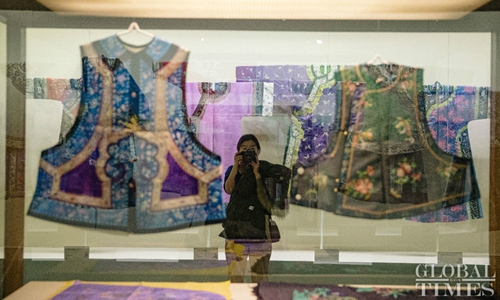HOME >> ARTS
Exhibition on ‘Dream of the Red Chamber’ kicks off in Beijing
Source:Global Times Published: 2019/12/20 22:40:18

Photo: Li Hao/GT
Some have described it as a Chinese Gone with the Wind, while some have called it the Chinese War and Peace. It is unanimously regarded as one of the four great classic novels of Chinese literature. Nearly 600 related items are on display at the National Museum of China (NMC) in Beijing to showcase the charm of Hongloumeng.
Translated as Dream of the Red Chamber in English, it was first published in 1791. It was written by Cao Xueqin in the mid-18th century during the Qing Dynasty (1644-1911), depicting the vicissitudes of aristocratic families.
Precious
"This is a world-class classic that deserves timeless reflection and appreciation," said Hu Deping, director of The Cao Xueqin Society at the opening ceremony on Friday.
The three-month exhibition is the largest-scale exhibition on the book so far. Through various items such as paintings, different editions and translated versions of the book, the exhibition shows the background of the creation, the far-reaching influence and the significant status of Dream of the Red Chamber in Chinese culture. Notably, some highly valuable pieces will also be on display, such as the manuscripts of the book by Feng Qiyong, a renowned Chinese scholar famous for his contributions to Redology, the study of Dream of the Red Chamber.
At the same time, Painting of Daguanyuan, a precious piece in the NMC's collection, will make its public debut for the first time. Daguanyuan, which literally means grand view garden, is a large landscaped garden built within Rongguofu, a mansion that belonged to one of the aristocratic families in the book. It is a key setting for much of the book. The painting was by an anonymous painter of the Qing Dynasty (1644-1911). With 173 figures in the painting, it is regarded as a valuable item for studying Dream of the Red Chamber.
Delicious
In addition to discovering the stories of the literary classic through the 600 items on display, visitors can also try Dream-of-the-Red-Chamber-themed desserts at the NMC cafe. Inspired by eight main female characters, the desserts have different flower-shapes and flavors such as date, chestnut, passion fruit and oolong tea. The desserts are called tang guozi.
"Tang guozi are not mooncakes, although they look similar," Liao Fei, director of the NMC gastronomy center told the media at a press conference on December 12. The museum hopes to bring back the skills and tradition of such bakery by including it in the exhibition.
"Tang guozi is a traditional dessert pairing with tea. It originated in the Tang Dynasty (618-907), thrived in the Song Dynasty (960-1279) and was later introduced to Japan," said Liao.
Influence abroad
The Los Angeles Times described Dream of the Red Chamber as "an artfully nuanced look at domestic life in 18th century China, placed within a philosophical and spiritual context of Buddhism, Confucianism and Taoism." The intricacy of the masterpiece has drawn artists from different countries to interpret the work in various ways.
For instance, Argentinean artist Leandro Erlich held an exhibition titled The Confines of the Great Void in July at the CAFA (The Central Academy of Fine Arts) Art Museum in Beijing. The title was inspired by a chapter from the book. "He was intrigued by the book, as many stories and traditional Chinese moral concepts from it were rather refreshing and foreign to Westerners like him," said Zhang Zikang, curator of the museum.
However, the length of the book and the staggering number of difficult Chinese names can make it hard for non-Chinese readers to follow. In the English version published by Penguin during the 1970s and 1980s, the number of pages reached 2,500 - twice as long as War and Peace. Any expats in Beijing who are interested in the classic shouldn't miss the exhibition to gain a better understanding about it.
Global Times
Posted in: ART,CULTURE & LEISURE